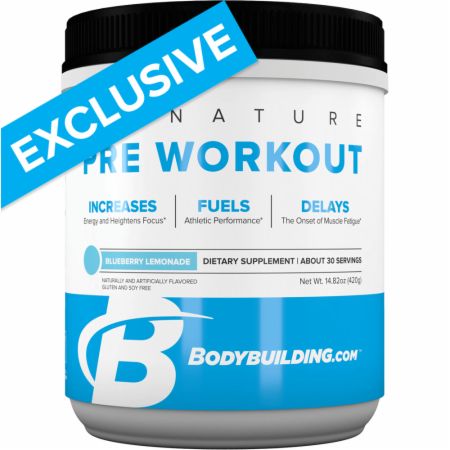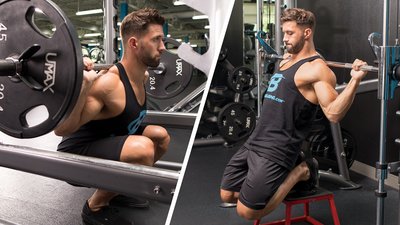The first time you see some of the moves Team Bodybuilding.com athlete Julian "The Quad Guy" Smith does to build his legs in the gym, your jaw will hit the floor. But with his feathered quads and shredded hamstrings, Smith has the size and definition to defend his extraordinary approach.
Smith is bringing back old-school bodybuilding exercises—and short shorts—in a very big way.
"The old-school guys didn't have half the stuff we have now," explains Smith. "You'd see pictures of Tom Platz doing sissy squats—there's no machine, there's no squat rack, no anything besides him and a dumbbell. Guys like Arnold and Tom Platz and Frank Zane—they just had a 'no bullshit' mindset to bodybuilding."
With an eye for detail and innovation, and an ability to create world-class workouts on the fly, Smith has become a compelling force of his own in the online fitness community. Here's how he built his wheels!
Julian Smith's Signature Moves for Legs
Sissy Squat
These really should be called "not for sissies" squats because they're a burner of the first order. Smith says they were essential for building his legs.
By shifting the weight onto your toes and forcing the front of your legs to support your entire body as you lower down, you're isolating the quads under stretch and demanding they lift all that weight back up without help from any other muscle group. Even with nothing but bodyweight, they're brutal!
If the thought of letting your knees track out over your toes and defying physics for quad growth has you trembling in your Nikes, you're not alone. The sissy squat is one move where Smith gets a lot of pushback, but he knows how to answer.
"Always perform sissy squats slow and controlled," he insists. "Momentum will get you injured!"
Start out with a 4-second negative as you lower your body to the ground, keeping your hips up and maintaining a straight line from your shoulders to your knees. If you're not comfortable using weight, you can get plenty out of this move with just bodyweight.
Explode up on the positive, pausing at the top to contract your quads hard. When done correctly with proper form, Smith says, this signature move will give you better quad definition than most bodybuilders!
Hack Squat Variations
If you're serious about building muscle in your legs, you already know the value of the hack squat. Already a versatile machine, Smith takes the hack squat to new levels by trying a wide variety of foot placements, tempos, and exercise combinations. He does them with a sumo stance, with heels together, and he even turns the hack squat into a sissy squat!
You already know Smith likes to emphasize the negative contraction in his movements, but for the hack squat, his emphasis shifts to the positives.
"As you start pressing up on the hack squat, push onto the outer part of the foot," says Smith. "This helps put extra tension on the outer sweep."

Cannonball Squats
As with sissy squats, the cannonball squat is a variation that can be done with a variety of equipment, as long as you understand the basic setup. Be warned, however—this move is a lot more difficult than it looks!
"The cannonball squat is a more advanced exercise," explains Smith. "If you have knee problems, limited mobility, or any pre-existing injuries, I would advise skipping this one or using an alternative exercise."
Stand with your heels touching and toes slightly pointed out. This is why you need good flexibility to perform the cannonball squat—you're taking multiple joints to extreme flexion on a very narrow base.
As you contract up, focus once again on pressing onto the outer part of the foot to help transfer tension to the outer sweep of your quads. Practice this move with light weight first before loading up the barbell, and make sure your knees, hips, and ankles are pain-free as you go through the movement.
If the back-loaded barbell version of these is out of reach, you can also perform a similar squat goblet-squat style, to kill the quads with very little back stress.
Paused-Contraction Extensions and Curls
This is a technique that can be applied to several different movements, most prominently leg extensions and hamstring curls. Smith calls them "striation makers!"
"Your legs act the same as your arms," explains Smith. "You extend with the quads the way you do with your triceps, and you curl with your hamstrings just like biceps, so why not train those muscles the way you train your arms?"
Leg extensions are the one exercise where you can fully contract and lock your quads while under tension. This differs from a squat, where you're standing and there isn't tension on the quads.
"Take a 5-second pause on each full contraction," says Smith. With nothing more than an EZ-bar draped over his ankles, he'll work up to 15-second holds!
Smith uses the same arm-training logic for his hamstring curls.
"Contract your hamstring the same way you'd flex your biceps into a ball," he says. "Hold for 4-5 seconds, then slowly lower back to the starting point."
You can add this extra flex into weighted hamstring curl variations, but Smith does these with just bodyweight, as well. It's hard to argue with a man who actually has a lower-body biceps peak!
Stiff-Legged Deadlifts
It's difficult to make something as familiar as dumbbell stiff-legged deadlifts into a signature move, but Smith uses this staple exercise in every way imaginable to build the back of his legs in ways that (almost) make his quads jealous.
One of his favorites is deficit deadlifts on top of plates to supersets and a pause at the bottom. Smith keeps the form cues on this move simple and to the point.
"Keep minimal bend in the legs—don't lock out, though—and only move your torso."
He'll also avoid the top range of motion so as to keep constant tension on his hamstrings. And don't be afraid to wear a belt for these, even with light weight. Smith does!
Deadlifts are difficult as it is, but the stiff-legged option requires extreme flexibility through the hamstrings. If you want to lift like Smith, make sure you include flexibility and mobility work in your weekly routine.
"The biggest mistake you can make in lifting is allowing your body to tighten up and expose yourself to potential injuries," says Smith. "Stretch, be mobile, and be an athlete!"
For more from our newest Bodybuilding.com-sponsored athlete, check Julian Smith's episode of the Bodybuilding.com Podcast.


